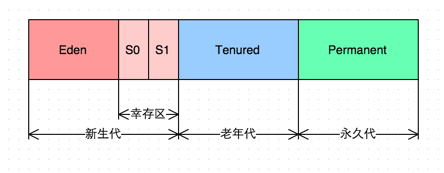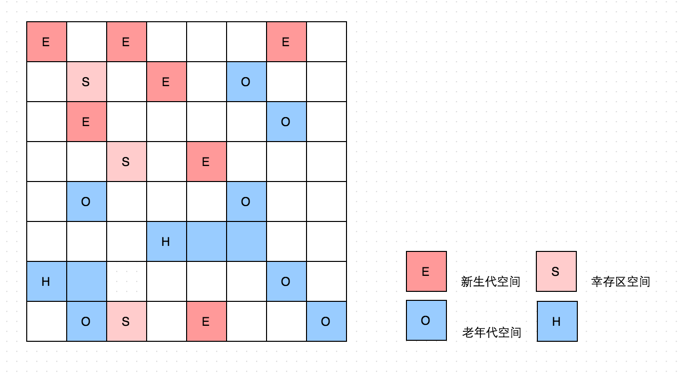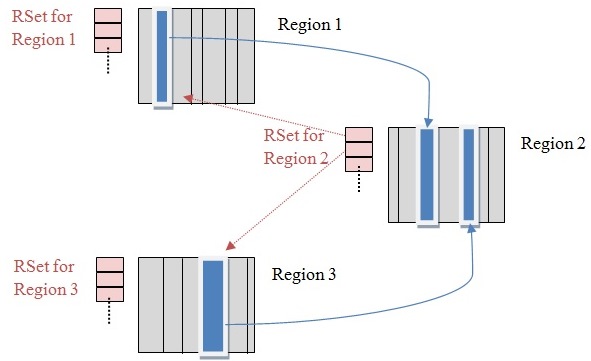【转】Java Hotspot G1 GC的一些关键技术
原文地址:https://tech.meituan.com/2016/09/23/g1.html
前言
G1 GC,全称Garbage-First Garbage Collector,通过-XX:+UseG1GC参数来启用,作为体验版随着JDK 6u14版本面世,在JDK 7u4版本发行时被正式推出,相信熟悉JVM的同学们都不会对它感到陌生。在JDK 9中,G1被提议设置为默认垃圾收集器(JEP 248)。在官网中,是这样描述G1的:
The Garbage-First (G1) collector is a server-style garbage collector, targeted for multi-processor machines with large memories. It meets garbage collection (GC) pause time goals with a high probability, while achieving high throughput. The G1 garbage collector is fully supported in Oracle JDK 7 update 4 and later releases. The G1 collector is designed for applications that:
- Can operate concurrently with applications threads like the CMS collector.
- Compact free space without lengthy GC induced pause times.
- Need more predictable GC pause durations.
- Do not want to sacrifice a lot of throughput performance.
- Do not require a much larger Java heap.
从官网的描述中,我们知道G1是一种服务器端的垃圾收集器,应用在多处理器和大容量内存环境中,在实现高吞吐量的同时,尽可能的满足垃圾收集暂停时间的要求。它是专门针对以下应用场景设计的:
- 像CMS收集器一样,能与应用程序线程并发执行。
- 整理空闲空间更快。
- 需要GC停顿时间更好预测。
- 不希望牺牲大量的吞吐性能。
- 不需要更大的Java Heap。
G1收集器的设计目标是取代CMS收集器,它同CMS相比,在以下方面表现的更出色:
- G1是一个有整理内存过程的垃圾收集器,不会产生很多内存碎片。
- G1的Stop The World(STW)更可控,G1在停顿时间上添加了预测机制,用户可以指定期望停顿时间。
有了以上的特性,难怪有人说它是一款驾驭一切的垃圾收集器(G1: One Garbage Collector To Rule Them All)。本文带大家来了解一下G1 GC的一些关键技术,为能正确的使用它,做好理论基础的铺垫。
G1中几个重要概念
在G1的实现过程中,引入了一些新的概念,对于实现高吞吐、没有内存碎片、收集时间可控等功能起到了关键作用。下面我们就一起看一下G1中的这几个重要概念。
Region
传统的GC收集器将连续的内存空间划分为新生代、老年代和永久代(JDK 8去除了永久代,引入了元空间Metaspace),这种划分的特点是各代的存储地址(逻辑地址,下同)是连续的。如下图所示: 
传统GC内存布局
而G1的各代存储地址是不连续的,每一代都使用了n个不连续的大小相同的Region,每个Region占有一块连续的虚拟内存地址。如下图所示: 
g1 GC内存布局
在上图中,我们注意到还有一些Region标明了H,它代表Humongous,这表示这些Region存储的是巨大对象(humongous object,H-obj),即大小大于等于region一半的对象。H-obj有如下几个特征:
- H-obj直接分配到了old gen,防止了反复拷贝移动。
- H-obj在global concurrent marking阶段的cleanup 和 full GC阶段回收。
- 在分配H-obj之前先检查是否超过 initiating heap occupancy percent和the marking threshold, 如果超过的话,就启动global concurrent marking,为的是提早回收,防止 evacuation failures 和 full GC。
为了减少连续H-objs分配对GC的影响,需要把大对象变为普通的对象,建议增大Region size。
一个Region的大小可以通过参数-XX:G1HeapRegionSize设定,取值范围从1M到32M,且是2的指数。如果不设定,那么G1会根据Heap大小自动决定。相关的设置代码如下:
1 | // share/vm/gc_implementation/g1/heapRegion.cpp |
SATB
全称是Snapshot-At-The-Beginning,由字面理解,是GC开始时活着的对象的一个快照。它是通过Root Tracing得到的,作用是维持并发GC的正确性。 那么它是怎么维持并发GC的正确性的呢?根据三色标记算法,我们知道对象存在三种状态:
- 白:对象没有被标记到,标记阶段结束后,会被当做垃圾回收掉。
- 灰:对象被标记了,但是它的field还没有被标记或标记完。
- 黑:对象被标记了,且它的所有field也被标记完了。
由于并发阶段的存在,Mutator和Garbage Collector线程同时对对象进行修改,就会出现白对象漏标的情况,这种情况发生的前提是:
- Mutator赋予一个黑对象该白对象的引用。
- Mutator删除了所有从灰对象到该白对象的直接或者间接引用。
对于第一个条件,在并发标记阶段,如果该白对象是new出来的,并没有被灰对象持有,那么它会不会被漏标呢?Region中有两个top-at-mark-start(TAMS)指针,分别为prevTAMS和nextTAMS。在TAMS以上的对象是新分配的,这是一种隐式的标记。对于在GC时已经存在的白对象,如果它是活着的,它必然会被另一个对象引用,即条件二中的灰对象。如果灰对象到白对象的直接引用或者间接引用被替换了,或者删除了,白对象就会被漏标,从而导致被回收掉,这是非常严重的错误,所以SATB破坏了第二个条件。也就是说,一个对象的引用被替换时,可以通过write barrier 将旧引用记录下来。
1 | // share/vm/gc_implementation/g1/g1SATBCardTableModRefBS.hpp |
SATB也是有副作用的,如果被替换的白对象就是要被收集的垃圾,这次的标记会让它躲过GC,这就是float garbage。因为SATB的做法精度比较低,所以造成的float garbage也会比较多。
RSet
全称是Remembered Set,是辅助GC过程的一种结构,典型的空间换时间工具,和Card Table有些类似。还有一种数据结构也是辅助GC的:Collection Set(CSet),它记录了GC要收集的Region集合,集合里的Region可以是任意年代的。在GC的时候,对于old->young和old->old的跨代对象引用,只要扫描对应的CSet中的RSet即可。 逻辑上说每个Region都有一个RSet,RSet记录了其他Region中的对象引用本Region中对象的关系,属于points-into结构(谁引用了我的对象)。而Card Table则是一种points-out(我引用了谁的对象)的结构,每个Card 覆盖一定范围的Heap(一般为512Bytes)。G1的RSet是在Card Table的基础上实现的:每个Region会记录下别的Region有指向自己的指针,并标记这些指针分别在哪些Card的范围内。 这个RSet其实是一个Hash Table,Key是别的Region的起始地址,Value是一个集合,里面的元素是Card Table的Index。
下图表示了RSet、Card和Region的关系(出处): 
Remembered Sets
上图中有三个Region,每个Region被分成了多个Card,在不同Region中的Card会相互引用,Region1中的Card中的对象引用了Region2中的Card中的对象,蓝色实线表示的就是points-out的关系,而在Region2的RSet中,记录了Region1的Card,即红色虚线表示的关系,这就是points-into。 而维系RSet中的引用关系靠post-write barrier和Concurrent refinement threads来维护,操作伪代码如下(出处):
1 | void oop_field_store(oop* field, oop new_value) { |
post-write barrier记录了跨Region的引用更新,更新日志缓冲区则记录了那些包含更新引用的Cards。一旦缓冲区满了,Post-write barrier就停止服务了,会由Concurrent refinement threads处理这些缓冲区日志。 RSet究竟是怎么辅助GC的呢?在做YGC的时候,只需要选定young generation region的RSet作为根集,这些RSet记录了old->young的跨代引用,避免了扫描整个old generation。 而mixed gc的时候,old generation中记录了old->old的RSet,young->old的引用由扫描全部young generation region得到,这样也不用扫描全部old generation region。所以RSet的引入大大减少了GC的工作量。
Pause Prediction Model
Pause Prediction Model 即停顿预测模型。它在G1中的作用是:
G1 uses a pause prediction model to meet a user-defined pause time target and selects the number of regions to collect based on the specified pause time target.
G1 GC是一个响应时间优先的GC算法,它与CMS最大的不同是,用户可以设定整个GC过程的期望停顿时间,参数-XX:MaxGCPauseMillis指定一个G1收集过程目标停顿时间,默认值200ms,不过它不是硬性条件,只是期望值。那么G1怎么满足用户的期望呢?就需要这个停顿预测模型了。G1根据这个模型统计计算出来的历史数据来预测本次收集需要选择的Region数量,从而尽量满足用户设定的目标停顿时间。 停顿预测模型是以衰减标准偏差为理论基础实现的:
1 | // share/vm/gc_implementation/g1/g1CollectorPolicy.hpp |
在这个预测计算公式中:davg表示衰减均值,sigma()返回一个系数,表示信赖度,dsd表示衰减标准偏差,confidence_factor表示可信度相关系数。而方法的参数TruncateSeq,顾名思义,是一个截断的序列,它只跟踪了序列中的最新的n个元素。
在G1 GC过程中,每个可测量的步骤花费的时间都会记录到TruncateSeq(继承了AbsSeq)中,用来计算衰减均值、衰减变量,衰减标准偏差等:
1 | // src/share/vm/utilities/numberSeq.cpp |
比如要预测一次GC过程中,RSet的更新时间,这个操作主要是将Dirty Card加入到RSet中,具体原理参考前面的RSet。每个Dirty Card的时间花费通过_cost_per_card_ms_seq来记录,具体预测代码如下:
1 | // share/vm/gc_implementation/g1/g1CollectorPolicy.hpp |
get_new_prediction就是我们开头说的方法,现在大家应该基本明白停顿预测模型的实现原理了。
GC过程
讲完了一些基本概念,下面我们就来看看G1的GC过程是怎样的。
G1 GC模式
G1提供了两种GC模式,Young GC和Mixed GC,两种都是完全Stop The World的。
- Young GC:选定所有年轻代里的Region。通过控制年轻代的region个数,即年轻代内存大小,来控制young GC的时间开销。
- Mixed GC:选定所有年轻代里的Region,外加根据global concurrent marking统计得出收集收益高的若干老年代Region。在用户指定的开销目标范围内尽可能选择收益高的老年代Region。
由上面的描述可知,Mixed GC不是full GC,它只能回收部分老年代的Region,如果mixed GC实在无法跟上程序分配内存的速度,导致老年代填满无法继续进行Mixed GC,就会使用serial old GC(full GC)来收集整个GC heap。所以我们可以知道,G1是不提供full GC的。
上文中,多次提到了global concurrent marking,它的执行过程类似CMS,但是不同的是,在G1 GC中,它主要是为Mixed GC提供标记服务的,并不是一次GC过程的一个必须环节。global concurrent marking的执行过程分为四个步骤:
- 初始标记(initial mark,STW)。它标记了从GC Root开始直接可达的对象。
- 并发标记(Concurrent Marking)。这个阶段从GC Root开始对heap中的对象标记,标记线程与应用程序线程并行执行,并且收集各个Region的存活对象信息。
- 最终标记(Remark,STW)。标记那些在并发标记阶段发生变化的对象,将被回收。
- 清除垃圾(Cleanup)。清除空Region(没有存活对象的),加入到free list。
第一阶段initial mark是共用了Young GC的暂停,这是因为他们可以复用root scan操作,所以可以说global concurrent marking是伴随Young GC而发生的。第四阶段Cleanup只是回收了没有存活对象的Region,所以它并不需要STW。
Young GC发生的时机大家都知道,那什么时候发生Mixed GC呢?其实是由一些参数控制着的,另外也控制着哪些老年代Region会被选入CSet。
- G1HeapWastePercent:在global concurrent marking结束之后,我们可以知道old gen regions中有多少空间要被回收,在每次YGC之后和再次发生Mixed GC之前,会检查垃圾占比是否达到此参数,只有达到了,下次才会发生Mixed GC。
- G1MixedGCLiveThresholdPercent:old generation region中的存活对象的占比,只有在此参数之下,才会被选入CSet。
- G1MixedGCCountTarget:一次global concurrent marking之后,最多执行Mixed GC的次数。
- G1OldCSetRegionThresholdPercent:一次Mixed GC中能被选入CSet的最多old generation region数量。
除了以上的参数,G1 GC相关的其他主要的参数有:
| 参数 | 含义 |
|---|---|
| -XX:G1HeapRegionSize=n | 设置Region大小,并非最终值 |
| -XX:MaxGCPauseMillis | 设置G1收集过程目标时间,默认值200ms,不是硬性条件 |
| -XX:G1NewSizePercent | 新生代最小值,默认值5% |
| -XX:G1MaxNewSizePercent | 新生代最大值,默认值60% |
| -XX:ParallelGCThreads | STW期间,并行GC线程数 |
| -XX:ConcGCThreads=n | 并发标记阶段,并行执行的线程数 |
| -XX:InitiatingHeapOccupancyPercent | 设置触发标记周期的 Java 堆占用率阈值。默认值是45%。这里的java堆占比指的是non_young_capacity_bytes,包括old+humongous |
GC日志
G1收集器的日志与其他收集器有很大不同,源于G1独立的体系架构和数据结构,下面这两段日志来源于美团点评的CRM系统线上生产环境。
Young GC日志
我们先来看看Young GC的日志:
{Heap before GC invocations=12 (full 1):
garbage-first heap total 3145728K, used 336645K [0x0000000700000000, 0x00000007c0000000, 0x00000007c0000000)
region size 1024K, 172 young (176128K), 13 survivors (13312K)
Metaspace used 29944K, capacity 30196K, committed 30464K, reserved 1077248K
class space used 3391K, capacity 3480K, committed 3584K, reserved 1048576K
2014-11-14T17:57:23.654+0800: 27.884: [GC pause (G1 Evacuation Pause) (young)
Desired survivor size 11534336 bytes, new threshold 15 (max 15)
- age 1: 5011600 bytes, 5011600 total
27.884: [G1Ergonomics (CSet Construction) start choosing CSet, _pending_cards: 1461, predicted base time: 35.25 ms, remaining time: 64.75 ms, target pause time: 100.00 ms]
27.884: [G1Ergonomics (CSet Construction) add young regions to CSet, eden: 159 regions, survivors: 13 regions, predicted young region time: 44.09 ms]
27.884: [G1Ergonomics (CSet Construction) finish choosing CSet, eden: 159 regions, survivors: 13 regions, old: 0 regions, predicted pause time: 79.34 ms, target pause time: 100.00 ms]
, 0.0158389 secs]
[Parallel Time: 8.1 ms, GC Workers: 4]
[GC Worker Start (ms): Min: 27884.5, Avg: 27884.5, Max: 27884.5, Diff: 0.1]
[Ext Root Scanning (ms): Min: 0.4, Avg: 0.8, Max: 1.2, Diff: 0.8, Sum: 3.1]
[Update RS (ms): Min: 0.0, Avg: 0.3, Max: 0.6, Diff: 0.6, Sum: 1.4]
[Processed Buffers: Min: 0, Avg: 2.8, Max: 5, Diff: 5, Sum: 11]
[Scan RS (ms): Min: 0.0, Avg: 0.1, Max: 0.1, Diff: 0.1, Sum: 0.3]
[Code Root Scanning (ms): Min: 0.0, Avg: 0.1, Max: 0.2, Diff: 0.2, Sum: 0.6]
[Object Copy (ms): Min: 4.9, Avg: 5.1, Max: 5.2, Diff: 0.3, Sum: 20.4]
[Termination (ms): Min: 0.0, Avg: 0.0, Max: 0.0, Diff: 0.0, Sum: 0.0]
[GC Worker Other (ms): Min: 0.0, Avg: 0.4, Max: 1.3, Diff: 1.3, Sum: 1.4]
[GC Worker Total (ms): Min: 6.4, Avg: 6.8, Max: 7.8, Diff: 1.4, Sum: 27.2]
[GC Worker End (ms): Min: 27891.0, Avg: 27891.3, Max: 27892.3, Diff: 1.3]
[Code Root Fixup: 0.5 ms]
[Code Root Migration: 1.3 ms]
[Code Root Purge: 0.0 ms]
[Clear CT: 0.2 ms]
[Other: 5.8 ms]
[Choose CSet: 0.0 ms]
[Ref Proc: 5.0 ms]
[Ref Enq: 0.1 ms]
[Redirty Cards: 0.0 ms]
[Free CSet: 0.2 ms]
[Eden: 159.0M(159.0M)->0.0B(301.0M) Survivors: 13.0M->11.0M Heap: 328.8M(3072.0M)->167.3M(3072.0M)]
Heap after GC invocations=13 (full 1):
garbage-first heap total 3145728K, used 171269K [0x0000000700000000, 0x00000007c0000000, 0x00000007c0000000)
region size 1024K, 11 young (11264K), 11 survivors (11264K)
Metaspace used 29944K, capacity 30196K, committed 30464K, reserved 1077248K
class space used 3391K, capacity 3480K, committed 3584K, reserved 1048576K
}
[Times: user=0.05 sys=0.01, real=0.02 secs]
每个过程的作用如下:
- garbage-first heap total 3145728K, used 336645K [0x0000000700000000, 0x00000007c0000000, 0x00000007c0000000) 这行表示使用了G1垃圾收集器,total heap 3145728K,使用了336645K。
- region size 1024K, 172 young (176128K), 13 survivors (13312K) Region大小为1M,青年代占用了172个(共176128K),幸存区占用了13个(共13312K)。
- Metaspace used 29944K, capacity 30196K, committed 30464K, reserved 1077248K class space used 3391K, capacity 3480K, committed 3584K, reserved 1048576K java 8的新特性,去掉永久区,添加了元数据区,这块不是本文重点,不再赘述。需要注意的是,之所以有committed和reserved,是因为没有设置MetaspaceSize=MaxMetaspaceSize。
- [GC pause (G1 Evacuation Pause) (young) GC原因,新生代minor GC。
- [G1Ergonomics (CSet Construction) start choosing CSet, _pending_cards: 1461, predicted base time: 35.25 ms, remaining time: 64.75 ms, target pause time: 100.00 ms] 发生minor GC和full GC时,所有相关region都是要回收的。而发生并发GC时,会根据目标停顿时间动态选择部分垃圾对并多的Region回收,这一步就是选择Region。_pending_cards是关于RSet的Card Table。predicted base time是预测的扫描card table时间。
- [G1Ergonomics (CSet Construction) add young regions to CSet, eden: 159 regions, survivors: 13 regions, predicted young region time: 44.09 ms] 这一步是添加Region到collection set,新生代一共159个Region,13个幸存区Region,这也和之前的(172 young (176128K), 13 survivors (13312K))吻合。预计收集时间是44.09 ms。
- [G1Ergonomics (CSet Construction) finish choosing CSet, eden: 159 regions, survivors: 13 regions, old: 0 regions, predicted pause time: 79.34 ms, target pause time: 100.00 ms] 这一步是对上面两步的总结。预计总收集时间79.34ms。
- [Parallel Time: 8.1 ms, GC Workers: 4] 由于收集过程是多线程并行(并发)进行,这里是4个线程,总共耗时8.1ms(wall clock time)
- [GC Worker Start (ms): Min: 27884.5, Avg: 27884.5, Max: 27884.5, Diff: 0.1] 收集线程开始的时间,使用的是相对时间,Min是最早开始时间,Avg是平均开始时间,Max是最晚开始时间,Diff是Max-Min(此处的0.1貌似有问题)
- [Ext Root Scanning (ms): Min: 0.4, Avg: 0.8, Max: 1.2, Diff: 0.8, Sum: 3.1] 扫描Roots花费的时间,Sum表示total cpu time,下同。
- [Update RS (ms): Min: 0.0, Avg: 0.3, Max: 0.6, Diff: 0.6, Sum: 1.4] [Processed Buffers: Min: 0, Avg: 2.8, Max: 5, Diff: 5, Sum: 11] Update RS (ms)是每个线程花费在更新Remembered Set上的时间。
- [Scan RS (ms): Min: 0.0, Avg: 0.1, Max: 0.1, Diff: 0.1, Sum: 0.3] 扫描CS中的region对应的RSet,因为RSet是points-into,所以这样实现避免了扫描old generadion region,但是会产生float garbage。
- [Code Root Scanning (ms): Min: 0.0, Avg: 0.1, Max: 0.2, Diff: 0.2, Sum: 0.6] 扫描code root耗时。code root指的是经过JIT编译后的代码里,引用了heap中的对象。引用关系保存在RSet中。
- [Object Copy (ms): Min: 4.9, Avg: 5.1, Max: 5.2, Diff: 0.3, Sum: 20.4] 拷贝活的对象到新region的耗时。
- [Termination (ms): Min: 0.0, Avg: 0.0, Max: 0.0, Diff: 0.0, Sum: 0.0] 线程结束,在结束前,它会检查其他线程是否还有未扫描完的引用,如果有,则”偷”过来,完成后再申请结束,这个时间是线程之前互相同步所花费的时间。
- [GC Worker Other (ms): Min: 0.0, Avg: 0.4, Max: 1.3, Diff: 1.3, Sum: 1.4] 花费在其他工作上(未列出)的时间。
- [GC Worker Total (ms): Min: 6.4, Avg: 6.8, Max: 7.8, Diff: 1.4, Sum: 27.2] 每个线程花费的时间和。
- [GC Worker End (ms): Min: 27891.0, Avg: 27891.3, Max: 27892.3, Diff: 1.3] 每个线程结束的时间。
- [Code Root Fixup: 0.5 ms] 用来将code root修正到正确的evacuate之后的对象位置所花费的时间。
- [Code Root Migration: 1.3 ms] 更新code root 引用的耗时,code root中的引用因为对象的evacuation而需要更新。
- [Code Root Purge: 0.0 ms] 清除code root的耗时,code root中的引用已经失效,不再指向Region中的对象,所以需要被清除。
- [Clear CT: 0.2 ms] 清除card table的耗时。
- [Other: 5.8 ms] [Choose CSet: 0.0 ms] [Ref Proc: 5.0 ms] [Ref Enq: 0.1 ms] [Redirty Cards: 0.0 ms] [Free CSet: 0.2 ms] 其他事项共耗时5.8ms,其他事项包括选择CSet,处理已用对象,引用入ReferenceQueues,释放CSet中的region到free list。
- [Eden: 159.0M(159.0M)->0.0B(301.0M) Survivors: 13.0M->11.0M Heap: 328.8M(3072.0M)->167.3M(3072.0M)] 新生代清空了,下次扩容到301MB。
global concurrent marking 日志
对于global concurrent marking过程,它的日志如下所示:
66955.252: [G1Ergonomics (Concurrent Cycles) request concurrent cycle initiation, reason: occupancy higher than threshold, occupancy: 1449132032 bytes, allocation request: 579608 bytes, threshold: 1449
551430 bytes (45.00 %), source: concurrent humongous allocation]
2014-12-10T11:13:09.532+0800: 66955.252: Application time: 2.5750418 seconds
66955.259: [G1Ergonomics (Concurrent Cycles) request concurrent cycle initiation, reason: requested by GC cause, GC cause: G1 Humongous Allocation]
{Heap before GC invocations=1874 (full 4):
garbage-first heap total 3145728K, used 1281786K [0x0000000700000000, 0x00000007c0000000, 0x00000007c0000000)
region size 1024K, 171 young (175104K), 27 survivors (27648K)
Metaspace used 116681K, capacity 137645K, committed 137984K, reserved 1171456K
class space used 13082K, capacity 16290K, committed 16384K, reserved 1048576K
66955.259: [G1Ergonomics (Concurrent Cycles) initiate concurrent cycle, reason: concurrent cycle initiation requested]
2014-12-10T11:13:09.539+0800: 66955.259: [GC pause (G1 Humongous Allocation) (young) (initial-mark)
…….
2014-12-10T11:13:09.597+0800: 66955.317: [GC concurrent-root-region-scan-start]
2014-12-10T11:13:09.597+0800: 66955.318: Total time for which application threads were stopped: 0.0655753 seconds
2014-12-10T11:13:09.610+0800: 66955.330: Application time: 0.0127071 seconds
2014-12-10T11:13:09.614+0800: 66955.335: Total time for which application threads were stopped: 0.0043882 seconds
2014-12-10T11:13:09.625+0800: 66955.346: [GC concurrent-root-region-scan-end, 0.0281351 secs]
2014-12-10T11:13:09.625+0800: 66955.346: [GC concurrent-mark-start]
2014-12-10T11:13:09.645+0800: 66955.365: Application time: 0.0306801 seconds
2014-12-10T11:13:09.651+0800: 66955.371: Total time for which application threads were stopped: 0.0061326 seconds
2014-12-10T11:13:10.212+0800: 66955.933: [GC concurrent-mark-end, 0.5871129 secs]
2014-12-10T11:13:10.212+0800: 66955.933: Application time: 0.5613792 seconds
2014-12-10T11:13:10.215+0800: 66955.935: [GC remark 66955.936: [GC ref-proc, 0.0235275 secs], 0.0320865 secs]
[Times: user=0.05 sys=0.00, real=0.03 secs]
2014-12-10T11:13:10.247+0800: 66955.968: Total time for which application threads were stopped: 0.0350098 seconds
2014-12-10T11:13:10.248+0800: 66955.968: Application time: 0.0001691 seconds
2014-12-10T11:13:10.250+0800: 66955.970: [GC cleanup 1178M->632M(3072M), 0.0060632 secs]
[Times: user=0.02 sys=0.00, real=0.01 secs]
2014-12-10T11:13:10.256+0800: 66955.977: Total time for which application threads were stopped: 0.0088462 seconds
2014-12-10T11:13:10.257+0800: 66955.977: [GC concurrent-cleanup-start]
2014-12-10T11:13:10.259+0800: 66955.979: [GC concurrent-cleanup-end, 0.0024743 secs
这次发生global concurrent marking的原因是:humongous allocation,上面提过在巨大对象分配之前,会检测到old generation 使用占比是否超过了 initiating heap occupancy percent(45%),因为 1449132032(used)+ 579608(allocation request:) > 1449551430(threshold),所以触发了本次global concurrent marking。对于具体执行过程,上面的表格已经详细讲解了。值得注意的是上文中所说的initial mark往往伴随着一次YGC,在日志中也有体现:GC pause (G1 Humongous Allocation) (young) (initial-mark)。
后记
因为篇幅的关系,也受限于能力水平,本文只是简单了介绍了G1 GC的基本原理,很多细节没有涉及到,所以说只能算是为研究和使用它的同学打开了一扇门。一个日本人专门写了一本书《彻底解剖「G1GC」 アルゴリズ》详细的介绍了G1 GC,这本书也被作者放到了GitHub上,详见参考文献5。另外,莫枢在这方面也研究的比较多,读者可以去高级语言虚拟机论坛向他请教,本文的很多内容也是我在此论坛上请教过后整理的。总而言之,G1是一款非常优秀的垃圾收集器,尽管还有些不完美(预测模型还不够智能),但是希望有更多的同学来使用它,研究它,提出好的建议,让它变的更加完善。